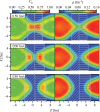Nuclear clustering-manifestations of non-uniformity in nuclei
- PMID: 38910397
- PMCID: PMC11343306
- DOI: 10.1098/rsta.2023.0123
Nuclear clustering-manifestations of non-uniformity in nuclei
Abstract
Well-developed [Formula: see text] clusters are known to exist in light [Formula: see text] nuclei, and their properties are reasonably well described with modern nuclear structure theories. However, 'modestly' developed clusters in medium to heavy nuclei remain little understood, both theoretically and experimentally. Extension of the focus to include modestly developed clusters leads us to a concept of 'generalized clusters' and 'cluster ubiquitousness'. The former includes clusters more weakly bound than an [Formula: see text] cluster, such as deuteron, triton and [Formula: see text], and even clusters partially broken owing to nuclear medium effects. The latter means the existence of clusters in any nuclei, where cluster development was not previously discussed. Effects of the tensor and the spin-orbit interactions on the coexistence of clusters with independent nucleons are discussed using recent nuclear theoretical models. A mixture of the clusters with shell-like components plays an essential role in the synthesis of elements in the universe and the origin of life, together with an [Formula: see text] decay. It is also pointed out that clustering in heavy nuclei may accelerate fission and fusion processes. Future experimental plans using cluster knockout reactions, which have the potential to extract information of 'generalized clusters' in a variety of nuclei including stable and unstable nuclei, are also discussed. This article is part of the theme issue 'The liminal position of Nuclear Physics: from hadrons to neutron stars'.
Keywords: alpha decay; knockout reaction; nuclear cluster; origin of elements; spin–orbit interaction; tensor interaction.
Conflict of interest statement
We declare we have no competing interests.
Figures









References
-
- Rutherford E. 1899. Uranium radiation and the electrical conduction produced by it. Philos. Mag. Ser. 5 47 , 109–163. (10.1080/14786449908621245) - DOI
-
- Rutherford E. 1911. The scattering of α and β particles by matter and the structure of the atom. Philos. Mag. Ser. 6 21 , 669–688. (10.1080/14786440508637080) - DOI
-
- Rutherford E. 1919. Collision of α particles with light atoms. IV. An anomalous effect in nitrogen. Philos. Mag. Ser. 6. 37 , 581. (10.1080/14786440608635919) - DOI
-
- Gamow G. 1928. Zur Quantentheorie des Atomkernes. Z. Physik 51 , 204–212. (10.1007/BF01343196) - DOI
-
- Wheeler JA. 1937. Molecular viewpoints in nuclear structure. Phys. Rev. 52 , 1083–1106. (10.1103/PhysRev.52.1083) - DOI
Publication types
Grants and funding
LinkOut - more resources
Full Text Sources

